South Bali by Helicopter: GWK, Uluwatu & Two Coastlines Compared
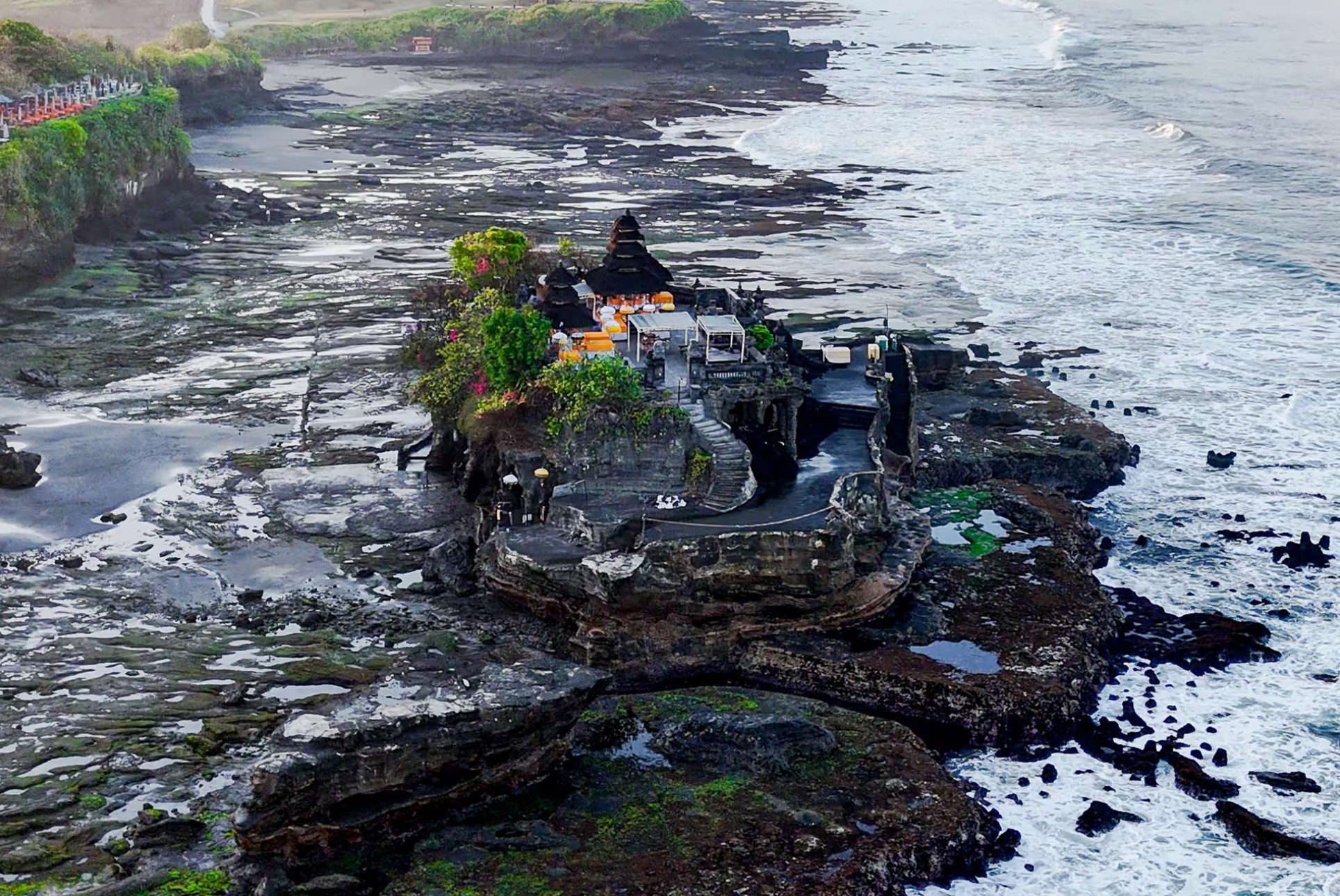
Few places on Earth deliver a coastline as dramatic as Bali’s southern tip. From the air, it’s a sweep of turquoise bays, limestone cliffs dropping straight into the ocean, and temples perched impossibly on the edge of rock. The flight path takes you over giants: the 120-meter GWK statue, the legendary Uluwatu Temple, and beaches like Melasti and Pandawa, where white sand collides with aquamarine surf.

Balicopter offers three ways to see this stretch of paradise from above. Choose the 10-minute South Bali hop for a taste of flight — perfect if you’re curious or short on time. Opt for the 15-minute Uluwatu route to circle the island’s most famous temple and its cliffs. Or, if you want the full panorama, the 35-minute Canggu & Uluwatu tour strings together two entire coastlines: from Tanah Lot and the surf breaks of Seminyak to the sheer walls of the Bukit Peninsula.
Each tour includes instant booking confirmation, a flexible cancellation policy, and the reassurance of modern aircraft flown by experienced pilots. The only decision left: how much of Bali do you want to see in one unforgettable flight?
Quick Choice: Which Tour Suits You Best?
Not every traveler comes to South Bali with the same schedule or appetite for adventure. That’s why Balicopter splits the southern routes into three distinct experiences. Think of it as choosing between a highlight reel, a feature film, or the director’s cut.
- South Bali Helicopter Tour — 10 minutes (Nusa Dua) The perfect first taste of flight. In just ten minutes you lift off over Nusa Dua, sweep past the towering GWK statue, and glide along the cliffs of Melasti and Pandawa Beach. Short, sharp, and breathtaking — ideal for families, first-timers, or anyone wanting a quick splash of adrenaline between beach days.
- Uluwatu Helicopter Tour — 15 minutes (Nusa Dua) If you’ve seen photos of Bali’s cliffs, this is the one. This route arcs around the island’s southern crown jewel: Uluwatu Temple, perched high above crashing surf. The extra five minutes mean more coastline, more temples, and the kind of aerial shots that end up as your trip’s signature memory.
- Canggu & Uluwatu: A Tale of Two Coastlines — 35 minutes (Canggu/Nuanu)
For those who want it all. This extended journey links Bali’s west coast with the south in a single flight: from Tanah Lot temple and the surf breaks of Canggu, Seminyak, and Kuta, across the bay to the cliffs of Dreamland and Uluwatu, finishing with the turquoise bays of Melasti and Pandawa. Thirty-five minutes in the air feels like a full day’s sightseeing — minus the traffic.
In short: 10 minutes for a taste, 15 for the icons, 35 for the ultimate south Bali panorama.
Compare the Tours at a Glance
Sometimes it helps to see everything side by side. Here’s a quick breakdown of what each southern route offers — from duration to highlights and pricing.

All tours include: instant booking confirmation, free cancellation, in-flight commentary, photo opportunities before take-off, and a comfortable lounge experience while you wait for boarding.
Route Breakdown: South Bali — 10 Minutes
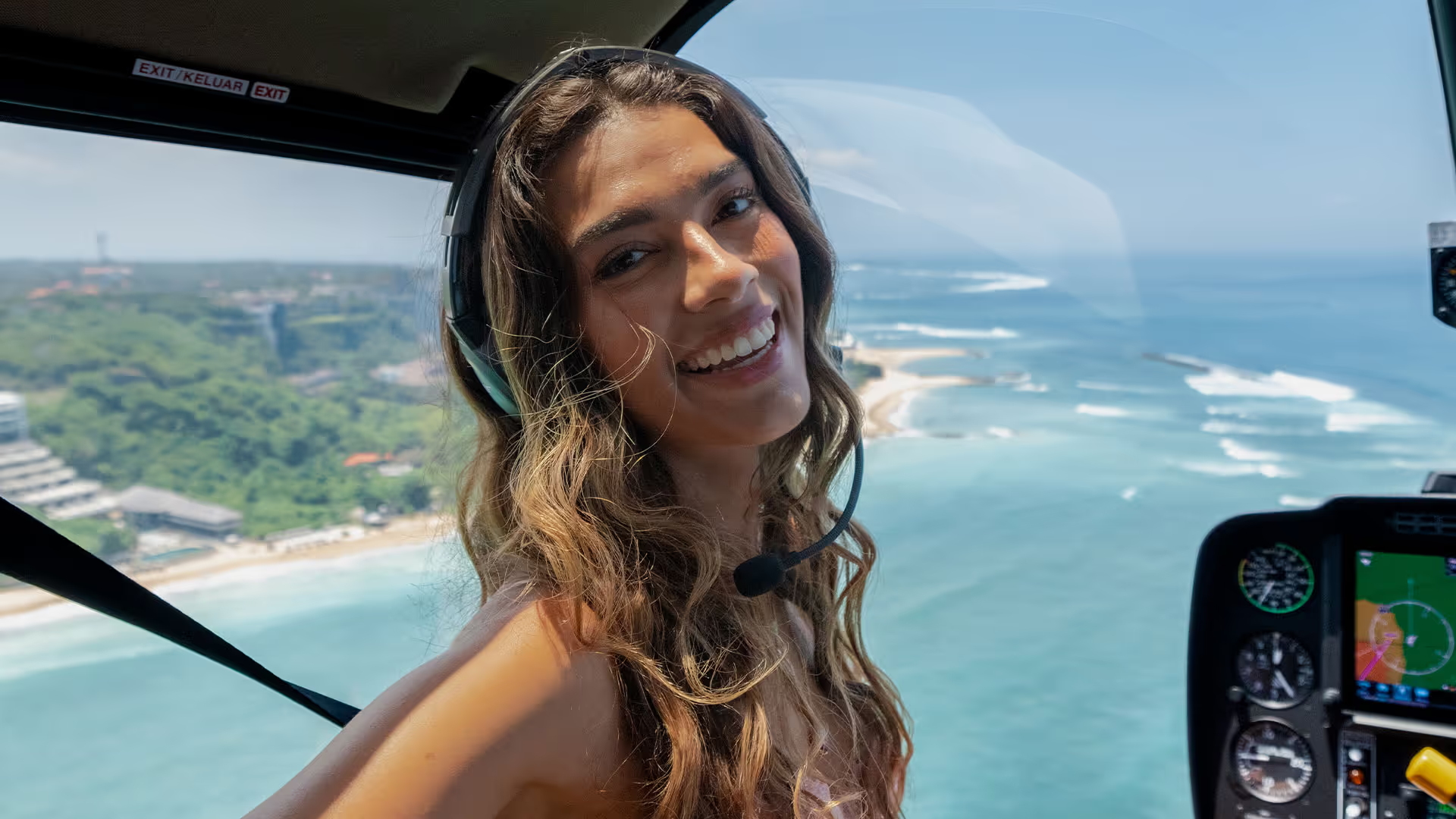
This is the shortest tour in Balicopter’s lineup, but it delivers a compact showcase of Bali’s southern edge. Departing from Nusa Dua Heliport, the helicopter rises quickly over the coastline, and within seconds you’re face to face with the colossal Garuda Wisnu Kencana (GWK) statue, standing 120 meters tall. From above, the sheer scale of the monument is striking — the kind of view you can’t get from the crowded park below.
The route continues over the Melasti and Pandawa cliffs, two of Bali’s most photogenic beaches. From the air, you see a contrast that defines the Bukit Peninsula: sheer limestone walls giving way to strips of white sand and bright turquoise shallows. A final sweep along the shoreline of Nusa Dua offers a glimpse of luxury resorts and reef-protected lagoons before the helicopter circles back to land.
Who it’s for:
- First-time flyers who want to experience the sensation of a helicopter ride without committing to a long flight.
- Families with kids — short enough to hold their attention, but dramatic enough to make it memorable.
- Travelers on a tight schedule who want a high-adrenaline “highlight reel” of Bali’s south coast.
Route Breakdown: Uluwatu — 15 Minutes

If there’s one flight that captures Bali’s most iconic image, it’s this one. Taking off from Nusa Dua Heliport, the helicopter banks westward, first passing over the immense GWK statue, before tracing the rim of the Bukit Peninsula toward the island’s crown jewel — Uluwatu Temple.
From above, the temple appears almost surreal: a tiny silhouette perched on the edge of a sheer limestone cliff, waves hammering the base far below. The helicopter circles the promontory, giving you different angles of the temple and the rugged coastline. As you follow the line of cliffs, you’ll see the untouched stretch of Nyang Nyang Beach, a dramatic sweep of white sand and rolling surf.
The flight closes with a glide over Melasti and Pandawa, this time from a different angle than the 10-minute tour, allowing for wider panoramic shots. By the time you return to Nusa Dua, you’ve covered Bali’s most recognizable landmarks in just a quarter of an hour.
Who it’s for:
- Travelers who want the must-see aerials of Bali: Uluwatu Temple, dramatic cliffs, and postcard beaches.
- Couples and photographers looking for shots that instantly scream “Bali.”
- Visitors who have a bit more time to spare but still want a concise, high-impact experience.
Route Breakdown: Canggu & Uluwatu — 35 Minutes

This is the “director’s cut” of Bali’s southern skies — a journey that connects two completely different coastlines in one continuous loop. Taking off from Canggu (Nuanu) Heliport, the helicopter immediately sweeps over rice fields and surf towns before reaching the legendary Tanah Lot temple. From the air, Tanah Lot looks like a dark jewel in the ocean, waves exploding against its rocky pedestal. It’s one of the most dramatic ways to see Bali’s most photographed shrine.
From there, the route hugs the west coast, giving you a bird’s-eye view of Bali’s surfing heartland: Pererenan, Berawa, Seminyak, and Kuta Beach. You’ll see lines of white surf stretching to the horizon and the bustling coastline that defines Bali’s beach culture.
The helicopter then cuts south across the bay to the Bukit Peninsula, where the scenery changes instantly: sprawling golf courses, rugged cliffs, and world-famous breaks like Dreamland and Uluwatu. Circling the cliffs near Uluwatu Temple, you get the same jaw-dropping perspective as the 15-minute flight, before continuing further east to the turquoise bays of Melasti and Pandawa Beach.
Thirty-five minutes later, you’ve essentially traced Bali’s entire lower half from above — temples, surf towns, cliffs, and hidden beaches — in a way no road trip could ever match.
Who it’s for:
- Travelers who want the most complete aerial tour of Bali’s south.
- Content creators and photographers chasing variety: temples, beaches, surf towns, and cliffs all in one session.
- Couples or groups looking for a “bucket list” experience that feels like a once-in-a-lifetime memory.
Best Time to Fly: Light, Weather, and Comfort
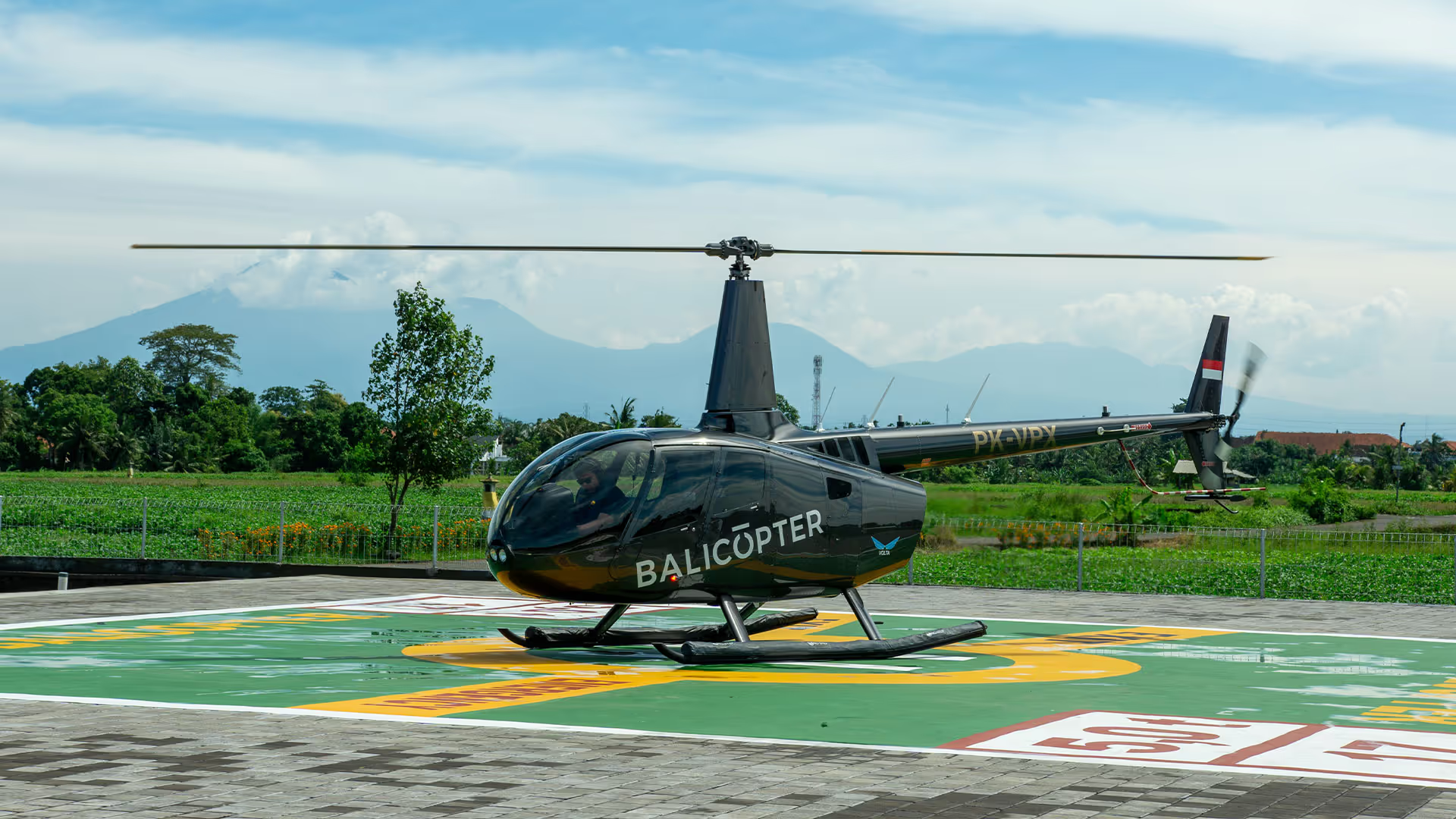
Helicopter flights over Bali are spectacular year-round, but timing makes all the difference in what you’ll see and how you’ll experience it.
Light for photography
- Morning flights (around 9–11 am) offer softer light, calmer winds, and clear visibility. Colors are vivid, and the air is less hazy — ideal if you’re hoping for bright photos of turquoise water and green cliffs.
- Afternoon flights (3–5 pm) bring warmer tones and dramatic shadows. This is the golden hour, when cliffs glow orange and the ocean looks deep blue. If you want atmosphere, this is the time.
- Midday flights give the most direct sunlight, but also harsher shadows and stronger glare off the water. Great for visibility, less so for photography.
Weather patterns
- Bali’s dry season (April to October) is the most reliable for flying. Clear skies and low humidity mean long visibility across both coastlines.
- Wet season flights (November to March) can still run smoothly, but short tropical showers and clouds are more common. Pilots carefully assess conditions — if weather makes flying unsafe, your tour will be rescheduled or refunded.
Comfort in the air
- Expect a steady, smooth ride: modern aircraft handle Bali’s coastal winds well.
- Over cliffs like Uluwatu, you may feel a light breeze and slight turbulence, but flights are short and managed by experienced pilots.
- Sunglasses help with glare, and light clothing is best (avoid bright white — it reflects inside the cabin and shows up in photos).
In short: mornings are crisp and clear, afternoons are cinematic, and evenings bring golden light but more chance of haze. The best plan is to book early in your trip, leaving room to reschedule if Bali’s weather decides otherwise.
Photo Guide: How to Capture the Perfect Shot

Flying over Bali’s cliffs and temples is unforgettable — but getting photos that do justice to the view takes a bit of preparation. Here’s how to come back with images that really capture the magic.
Choose your seat wisely
- Window seats are best, and most operators will assign them based on weight balance. If you’re flying with a group, mention your photography interest when checking in — crews often do their best to accommodate.
- On the 10- and 15-minute flights, the left side often gives better angles of GWK, Uluwatu, and the Bukit cliffs. On the 35-minute tour, both sides offer variety: left for temples, right for the wide sweep of Seminyak and Kuta.
Gear tips
- A smartphone with a good wide-angle lens is enough for stunning shots. For cameras, bring a zoom lens (24–70mm or similar) for flexibility.
- Use a wrist strap or neck strap — loose gear is not allowed in the cabin.
- A circular polarizing (CPL) filter helps cut glare from the helicopter windows and brings out the ocean’s deep turquoise tones.
Technique in the air
- Hold your camera or phone close to the glass to minimize reflections.
- Shoot in bursts — helicopters move quickly, and the best compositions often appear for just a second or two.
- Don’t forget vertical shots for Instagram stories and Reels; cliffs and temples look dramatic in portrait orientation.
Capture the icons
- GWK Statue: frame it against the ocean or catch the sunlight on its golden crown.
- Uluwatu Temple: wait for the circle around the cliff; you’ll get the temple perfectly isolated above crashing waves.
- Tanah Lot: best shot is slightly angled, showing the temple surrounded by foaming surf.
- Melasti & Pandawa: go wide — the turquoise bays and limestone cliffs look spectacular when captured together.
Pro tip: Don’t stay glued to the lens. Snap your shots, then put the camera down. Half the thrill is experiencing the coastline with your own eyes.
Safety and Restrictions
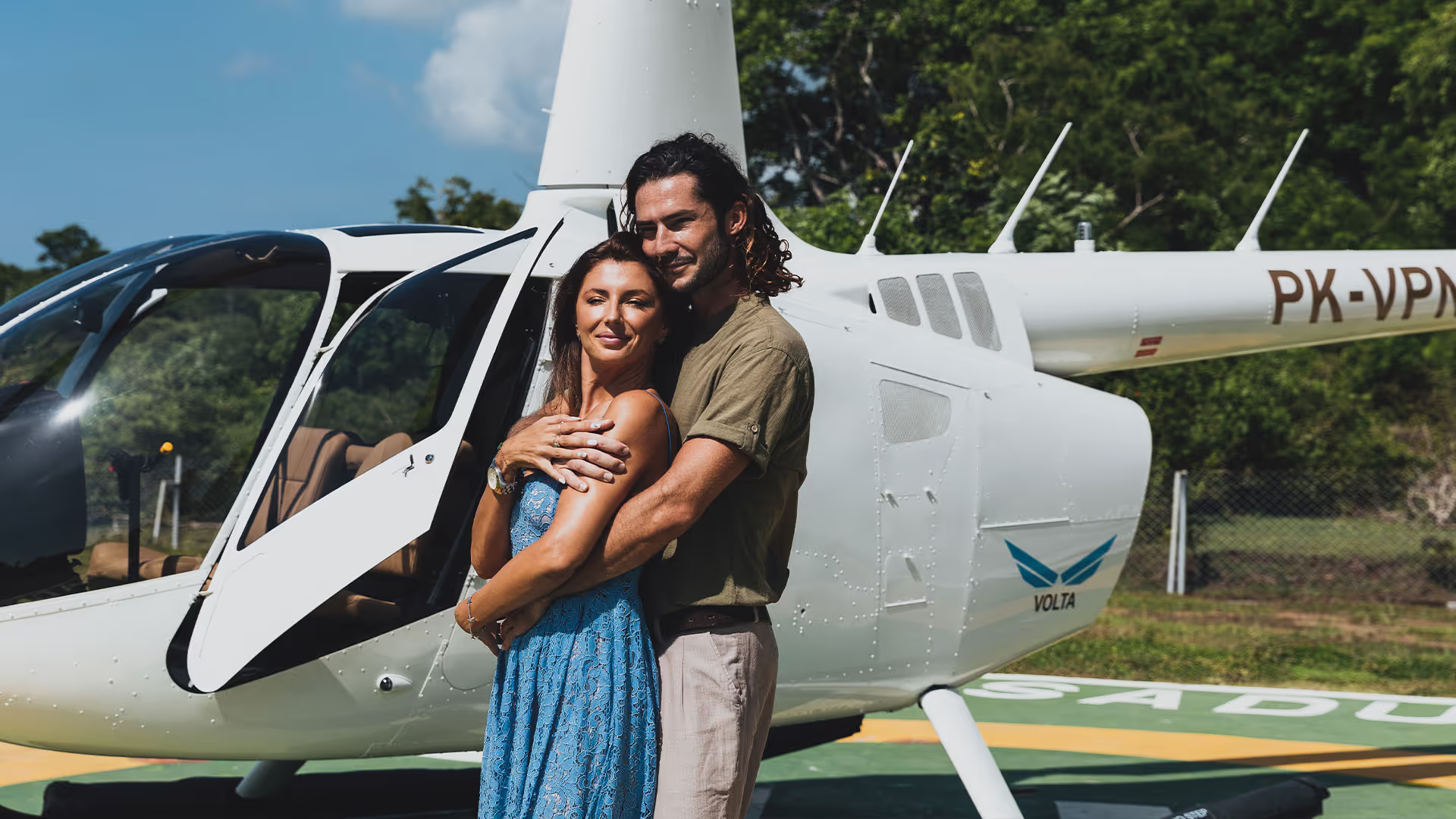
Helicopter tours are designed to be thrilling, but safety always comes first — and Bali’s operators follow international standards to ensure every flight is secure and comfortable.
Modern fleet
- Balicopter uses aircraft like the Robinson R66 and Bell 505, both known for reliability and visibility. Cabins are compact but designed with wide windows, so you don’t just feel safe — you also get unobstructed views.
Experienced pilots
- Every flight is handled by licensed pilots trained for Bali’s unique coastal conditions. They monitor weather, wind, and visibility carefully before takeoff.
- Briefings are given before every flight: how to buckle in, where to store loose items, and what to expect during takeoff and landing.
Weight and passenger limits
- Flights have strict capacity rules: the R66 helicopter carries up to 4 passengers, with a total weight limit of around 330 kg (including pilot). This ensures the aircraft remains balanced and safe.
- Seating arrangements are determined by crew for weight distribution — you can request a side, but final assignments depend on balance.
Weather policy
- If conditions aren’t safe — heavy rain, low visibility, or high winds — flights are delayed or rescheduled. Safety decisions rest with the pilot, and passengers receive a full refund or a new slot if flights are canceled.
Other restrictions
- Children are welcome, but infants under 2 may not be accepted on shared flights (private charters are more flexible).
- Large bags and unsecured items aren’t allowed on board. Cameras and phones must have wrist straps or lanyards.
- Passengers should arrive at the helipad 30 minutes before departure for check-in and briefing.
In short: the thrill is very real, but it’s managed within a framework that puts safety above everything else. You get the adrenaline, without the risk.
What’s Included and Optional Extras
-min.avif)
Every Balicopter tour is more than just a seat in the sky — it’s a curated experience designed to feel smooth from check-in to landing. Here’s what you can expect with each booking, and how you can enhance it further.
Always included
- Flight time as booked (10, 15, or 35 minutes), with all major landmarks covered in the route.
- Pre-flight safety briefing so you know what to expect before takeoff.
- Access to the lounge at the helipad: air-conditioned waiting area, refreshments, and space to relax before boarding.
- Photo opportunity beside the helicopter before or after the flight — perfect for a souvenir snapshot.
- Instant booking confirmation and a “Cancel anytime — 100% refund” policy for peace of mind.
Optional extras (on request or upgrade)
- Professional photo or video package: some travelers prefer to focus on the view while a photographer captures the highlights.
- Private charter upgrade: book the entire helicopter for a proposal, honeymoon surprise, or simply more space and privacy.
- Custom routes: add a landing stop for a beach picnic, resort transfer, or temple visit (availability depends on weather and permissions).
- Transfers from your hotel or villa: arrange private pick-up so your day flows seamlessly.
Good to know
- All extras should be requested at the time of booking or at least 24 hours before your flight.
- Private and custom tours are subject to aircraft availability — peak season dates can fill up weeks in advance.
The core package already covers the essentials, but with the right extras, your helicopter tour can shift from a memorable activity into a once-in-a-lifetime event.
Booking: How to Choose the Right Format and Save
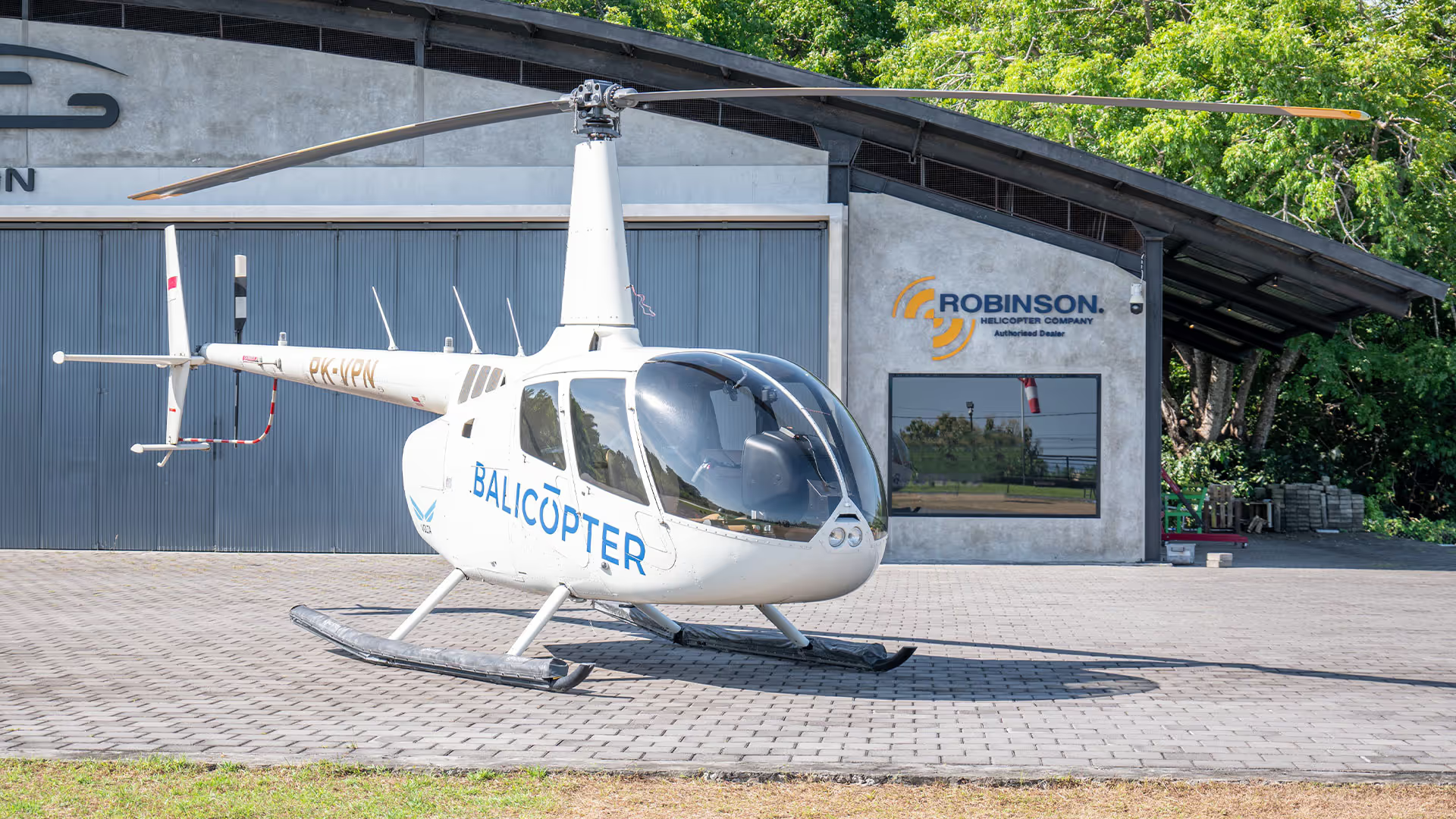
Helicopter tours aren’t just about choosing the route — the way you book can shape both your experience and your budget. Balicopter offers two main formats: shared seat or private charter.
Shared seat (per person pricing)
- You buy one or more seats on a scheduled flight. Other passengers may join you, depending on availability.
- It’s the most cost-effective way to experience a helicopter ride. For example, the 10-minute South Bali hop starts from IDR 1,990,000 per seat.
- Perfect for solo travelers, couples, or small groups who don’t mind sharing.
Private charter (entire helicopter)
- You book the whole aircraft — ideal for proposals, family trips, or simply having the cabin to yourself.
- Prices start from IDR 6,390,000 for the shortest tour, scaling up for the longer routes.
- Benefits include guaranteed seating arrangements, full privacy, and flexibility in timing.
When to choose which
- If your goal is just to fly and capture the views, the shared option is excellent value.
- If you want photos without strangers in the background, plan a surprise, or fly with young kids, private charter is worth the premium.
Tips to save
- Book online in advance: instant confirmation often comes with better promotional rates.
- Travel off-peak: mornings mid-week usually have more availability and lower demand.
- Group up: if you’re three or four people, the cost of private charter splits surprisingly evenly.
In the end, both formats deliver the same jaw-dropping scenery — it’s simply a matter of whether you prefer to share the ride or keep it all to yourself.
Route Maps and Google Maps Highlights
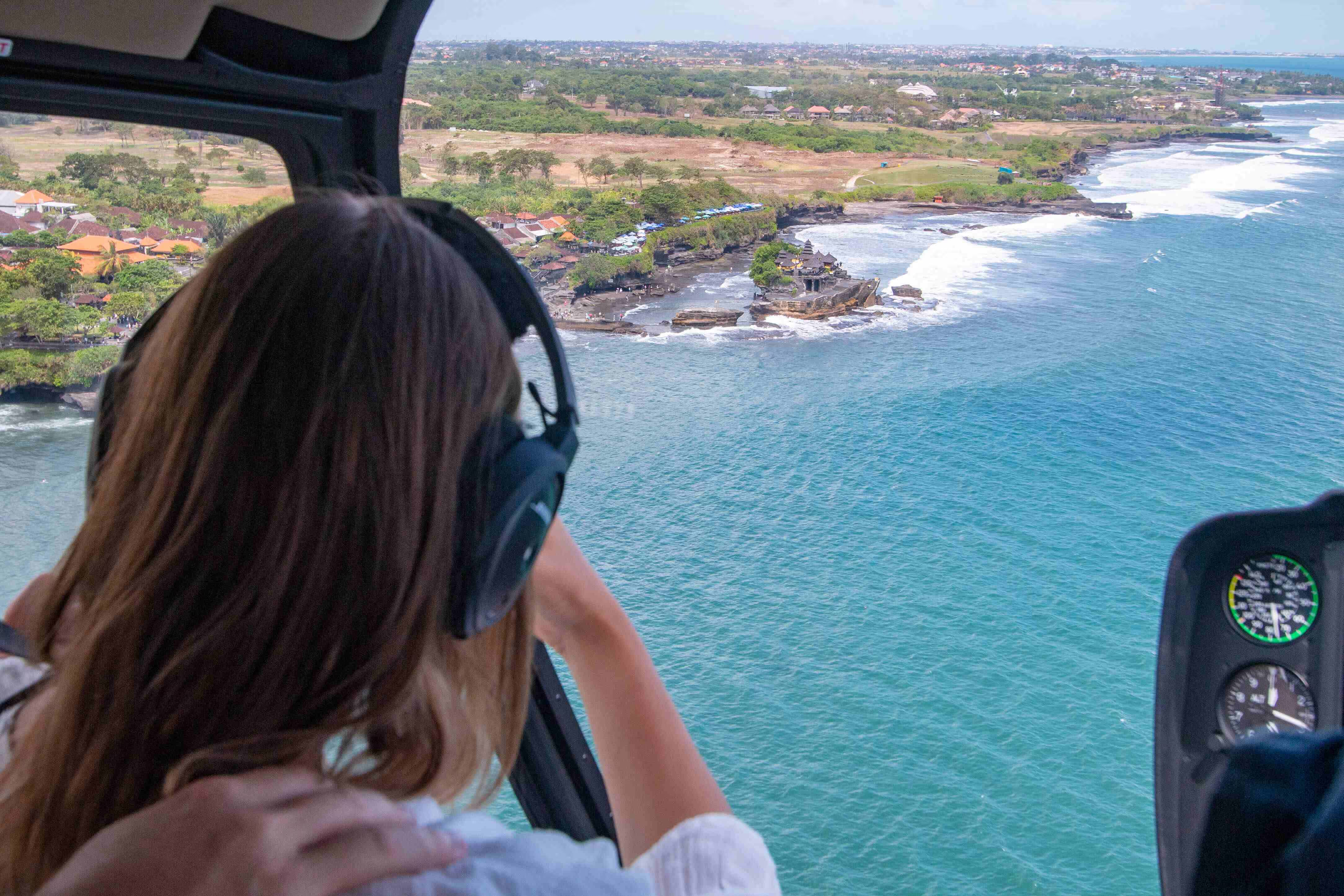
Seeing the flight path laid out on a map makes it easier to picture what’s ahead — and helps you plan which landmarks you’ll catch from the air. Each Balicopter tour has its own signature loop:
South Bali — 10 min (Nusa Dua)
- Depart Nusa Dua Heliport.
- Quick ascent over the coastline.
- Pass by the GWK statue — one of Bali’s tallest landmarks.
- Sweep along the turquoise bays of Melasti and Pandawa Beach.
- Circle back for a smooth landing in Nusa Dua.
- Depart Nusa Dua Heliport.
- Route extends past GWK toward the dramatic cliffs of the Bukit Peninsula.
- Orbit around Uluwatu Temple, perched high above the waves.
- Continue over Nyang Nyang Beach, then return via Melasti and Pandawa.
- Land back in Nusa Dua.
Canggu & Uluwatu — 35 min (Canggu/Nuanu)
- Take off from Canggu Heliport (Nuanu).
- Head west along the coast to Tanah Lot Temple, surrounded by surf.
- Fly south past Canggu, Seminyak, and Kuta Beach, watching the long surf breaks roll in.
- Cross the bay to the Bukit Peninsula: Dreamland, Uluwatu Temple, Nyang Nyang, Melasti, and Pandawa.
- Return to Canggu for landing.
Google Maps integration
Balicopter tour pages include embedded maps, letting you preview the route in detail. Pinch-zoom to spot each landmark — from the exact cliff where Uluwatu Temple sits to the curve of Tanah Lot’s rock base. This is especially useful if you’re trying to decide between the shorter flights or the full 35-minute coastline loop.
FAQ: Most Common Questions
Can children join the flights?
Yes, children are welcome on board. For shared tours, kids usually need their own seat if they’re over 2 years old. Infants may not be accepted on shared flights for safety reasons — in those cases, a private charter is recommended.
What should I wear and bring?
Light, comfortable clothing works best. Avoid bright white outfits, which can cause reflections in photos. Sunglasses help with glare. Cameras and phones are welcome, but they must have wrist straps or lanyards for safety.
What happens if the weather is bad?
Flights only operate in safe conditions. If rain, clouds, or wind make flying impossible, the pilot will reschedule your tour or issue a full refund. This is part of the “Cancel anytime — 100% refund” policy.
How many people can fly at once?
The Robinson R66 typically carries up to 4 passengers plus the pilot. The maximum combined passenger weight is around 330 kg. Seating arrangements are decided by the crew for balance and safety.
Can I choose my seat?
You can make a request, and crews will try to accommodate it, but final seating depends on weight distribution. Both sides of the helicopter offer excellent views.
How early should I arrive?
Plan to be at the helipad 30 minutes before departure for check-in, a short briefing, and safety instructions.
Is there a refund if I cancel myself?
Yes — all Balicopter tours include flexible cancellation with 100% refund, as long as you notify in advance through the booking system.
Conclusion
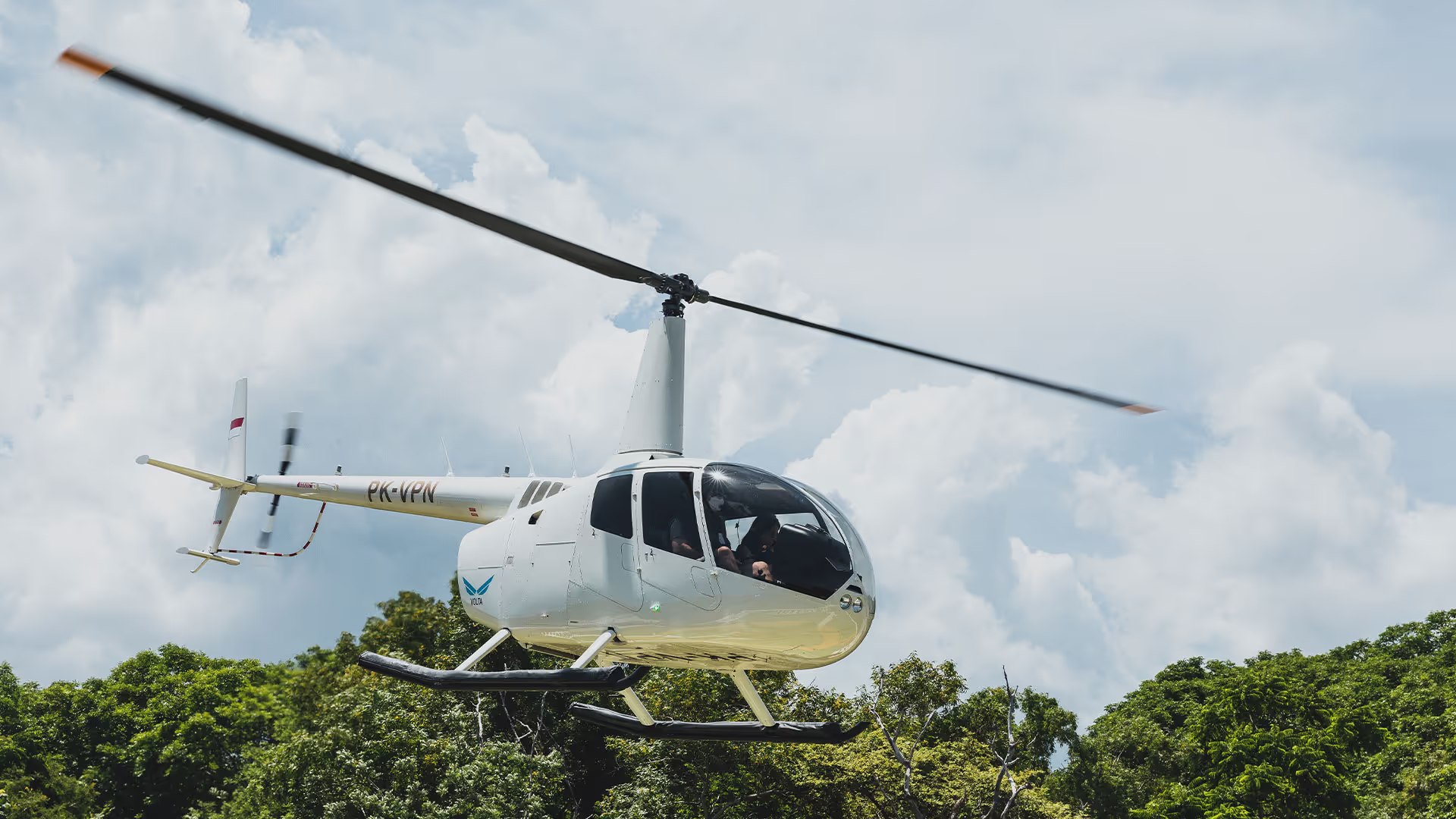
From the air, Bali’s south coast tells three very different stories — and the only real question is how much of it you want to see in a single flight.
Whichever you choose, you get the same standards — instant confirmation, free cancellation, modern helicopters, and the guidance of experienced pilots.
👉 Ready to see Bali from above? Explore the routes and book your seat:
- South Bali Helicopter Tour — 10 Minutes
- Uluwatu Helicopter Tour — 15 Minutes
- Canggu & Uluwatu: A Tale of Two Coastlines — 35 Minutes
Your perfect view of Bali isn’t on the road — it’s in the sky.
See more












.svg)
.svg)
.svg)